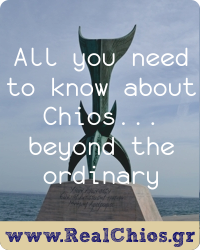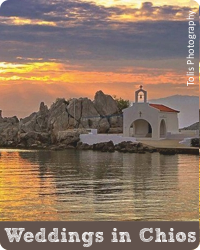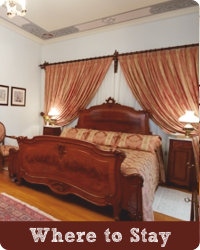What
a perfect day. We are in Chios, a magnificent island which lays at North-east
Aegean Sea, a sea where in accordance with Zorba the Greek (Nikos Kazantzakis)
: "Happy is the man, I thought, who, before dying, has the good fortune to
sail the Aegean sea".
Good
things happen in the morning so we are set to off around 9 a .m. The bus driver will
drive us through Mastihohoria (the villages in the south part of the island
where mastiha is produced) heading to village named Pyrgi where is our first
stop.
A
litle story about Pyrgi:
The
entire village of Pyrgi - 25 Km south of the town of Chios
It
has been designated a listed monument. It keeps its houses tied tightly
together in what seems like a closed and compact form. The streets are cobbled
and narrow. This type of fortress, a four-cornered structure, was built for
protection against the frequent attacks by pirates and Turks, as well as for
better cultivation of the mastic bush. It lies in small, treeless valleys far
from the sea. The gray houses had doors and windows that faced only the
interior of the wall, that is, inside the village. The outer walls contained
adjoining parapets with small towers at the corners and only one gate. The
inhabitants could enter and leave the village only through a door which can be
found today at the location Kato Porta.
At
the centre of Pyrgi rises the defence tower, where the inhabitants took refuge
in the case of attack, using a movable bridge. The streets are narrow,
stone-paved, and are connected to the central tower square. At frequent
intervals there are transverse archways supporting the structures, as well as
vaults and arches supporting the rooms. The functional character of the houses
was geared to defence, and thus the inhabitants were able to move about the
roofs without being seen. The four-sided shape of these houses, their thick
structure, the defence system, the small areas for general use, and their
relation to the treeless, natural surroundings, convince us that Pyrgi was
built on a fixed plan which may have been imposed by the Genoese.
At Pyrgi, one sees scraped designs called Xysta on the facades of the houses. This is a technique of hand-engraving geometric motifs in black and white on plaster. It is based on plastering-sand being applied to the wall, carefully painted white, then scraped with the designs. These Xysta, reminiscent of the Italian Sgraffito, a form of decoration which stems fromGenoa
At Pyrgi, one sees scraped designs called Xysta on the facades of the houses. This is a technique of hand-engraving geometric motifs in black and white on plaster. It is based on plastering-sand being applied to the wall, carefully painted white, then scraped with the designs. These Xysta, reminiscent of the Italian Sgraffito, a form of decoration which stems from
We
will be able to see:
The
St. Apostles church after a narrow arched gallery starting at the north-eastern
corner of the central square.
The
Central church of the village dedicated to the Assumption of Holy Mother.
A
walk around the narrow streets and alleys of the village is heartily
recommended.
Our
stop to Pyrgi village will take about an hour. Them we will be back to the bus
and the driver will drive us all the way to Mesta, probably
the most characteristic of the medieval villages. This village-castle remains
perfectly preserved since the Byzantine period .
A
litle story about Mesta:
Mesta in old medieval texts is mentioned as Amista, Amistae
and Lamiste. Perhaps in Greek it was named Amistha.
According to another view the name derives from the Byzantine word "mesta" which means "hard" (the opposite of "tender").
A third view is based on the shift of the initial letter of the word Vesta - Mesta. "Vestas" was the one responsible for the emperor's clothing. "Vestarhaton" used to be a feud given by the Emperor to "Vestas" in order to honour him.
Unverified tradition quotes that Mesta was founded by the dwellers of Meskia, a village inPeloponnese
and by the natives that used to live in various small settlements up to then.
They constructed the village by bordering it with a great wall.
Nowadays Mesta has 500 residents approximately. Many more are those who dwell inAthens ,
Thessaloniki and in the USA Athens and of
the USA
Many embellishment works have been taking place due to the villagers living abroad. In the past the communities ofEgypt and Russia made great offers to the village whereas
these days the communities of the USA
and Athens
The villagers themselves are vividly interested in the maintenance of their cultural heritage as well as in the environmental conservancy. As far as cultural issues are concerned there is the "Cultural Association of Mesta" and about the environment issues the Association of Amateur Fishermen "The Friends of Limenas of Mesta".
According to another view the name derives from the Byzantine word "mesta" which means "hard" (the opposite of "tender").
A third view is based on the shift of the initial letter of the word Vesta - Mesta. "Vestas" was the one responsible for the emperor's clothing. "Vestarhaton" used to be a feud given by the Emperor to "Vestas" in order to honour him.
Unverified tradition quotes that Mesta was founded by the dwellers of Meskia, a village in
Nowadays Mesta has 500 residents approximately. Many more are those who dwell in
Many embellishment works have been taking place due to the villagers living abroad. In the past the communities of
The villagers themselves are vividly interested in the maintenance of their cultural heritage as well as in the environmental conservancy. As far as cultural issues are concerned there is the "Cultural Association of Mesta" and about the environment issues the Association of Amateur Fishermen "The Friends of Limenas of Mesta".
Walking
around the narrow alleys you will realize how difficult it was for the attackers
to find their way through the village.
You will be able aslo to visit the Church of Great Taxiarchis and the church of older Taxiarchis.
Would you like to have a coffee here.? It is ok. Lithi is about 25 kms away from Mesta and there we will be able to enjoy the sea (the kids will be very happy of that) and we will enjoy a nice lunch.
5 p.m. will be the last call for jumping into the bus for the way to return to Chios. The bus will leave with or without you (maybe you will fall in love with Lithi and you would like to spend the rest of your life there but dont forget why you came to Chios....























0 σχόλια:
Δημοσίευση σχολίου